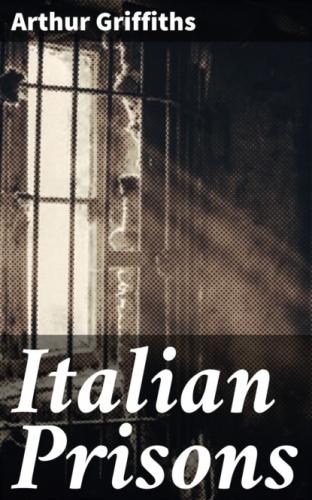Arthur Griffiths
Italian Prisons
St. Angelo; the Piombi; the Vicaria; Prisons of the Roman Inquisition
Published by Good Press, 2019
EAN 4064066125080
Table of Contents
CHAPTER I THE CASTLE OF ST. ANGELO
CHAPTER III THE GREAT SIEGE OF ST. ANGELO
CHAPTER IV ADVENTURES OF CELLINI
CHAPTER VI THE STORY OF THE CENCI
CHAPTER VII THE ROMAN INQUISITION
CHAPTER VIII LATER DAYS IN ROME
CHAPTER IX THE PIOMBI OF VENICE
CHAPTER X THE VICARIA OF NAPLES
CHAPTER XI THE CAMORRA AND THE MAFIA
INTRODUCTION
The Tomb of Hadrian, or Castle of St. Angelo, as it has been called since the famous vision of Gregory the Great, is a familiar object to every stranger in Rome. It stands above the yellow Tiber facing the ancient Aelian Bridge, now called also the Bridge of St. Angelo on the main road to St. Peter’s and the Vatican. It is connected with the latter by a subterranean passage built by Pope Alexander VI in 1500, and used by his successors as a path of retreat to the fortress in times of internal revolt or foreign attack. The great fortress prison, although dismantled of the marble that once covered its stones, is still a most imposing edifice and is second to none in the world in its historic memories, replete with strange and terrible interest. It is an epitome of Roman history, closely associated from the beginning of the Christian era down to the fall of the temporal power of the Popes, with the storms and struggles that have rent the Eternal City. Any account of Italian prisons must thus centre about this grim old relic of the Cæsars—“this massive mausoleum, by turns a tomb, a fortress, a prison and a palace, a chapel and a treasure-house; now threatening the liberty of Rome, now defending its very existence; now the refuge of the Republic, now the hiding place of the Popes; through war and peace, from the Imperial days on through the Gothic and Mediæval epochs, down to the present hour never ceasing to be a living part of the history of Rome.” Since 1890 it has been used as barracks for a branch of the Italian army, but visitors may yet see the apartments of the Popes and those horrible dungeons into which, in former days, no ray of light could penetrate. Until the French occupation of Rome, when doors were cut into them, they were entered through holes in the vaulted ceiling. Through these the wretched prisoners were let down into the fetid depths of these “sepulchres without the peace of the dead.” In them languished Benvenuto Cellini, the wizard Cagliostro, beautiful, unhappy Beatrice Cenci, and many others famous in song and story.
The records of this fortress-prison are largely the history of early and mediæval Rome, and in the severity of its punishments and the ruthless cruelty of its methods it stands as the type “writ large” of the prisons of Italy, for which, as it were, it set the pace.
For centuries before its unification under Victor Emanuel I, Italy had been split into many small, independent, and ever-warring states, each with its own penal code and methods of punishment, but each emulating the other in the arbitrariness of its methods and the diabolical cruelty of its punishments. When the prisons were taken over by the present government, they were unspeakably foul and ill-ventilated, and frightfully overcrowded. When Mr. Gladstone, moved by the rumours of their condition at the time of the imprisonment of the Neapolitan patriots, Paerio and Settembrini, penetrated into them in disguise, “he found the prisoners, men of stainless life, ex-cabinet ministers, authors, barristers, chained to common criminals and living in hideous degradation.” In St. Angelo, subterranean cells, which could be entered only by crawling on all fours, often held thrice the number for which they were destined. Here were huddled the innocent and the guilty, the untried and convicted. At this time ordinary prisoners were often employed beyond the gaol, compelled to drag their chains as they worked in the streets or private houses. Within, they were hired out to contractors who were fined for every idle man. Discipline was maintained by confinement in a black hole, or by resort to starvation, irons or the stick. Many such instruments may still be seen by the visitor to St. Angelo. In the Roman prison food was very scarce, and to provide it and otherwise alleviate the sufferings of the wretched inmates, was the special vocation of many pious confraternities, of which some account is given in these pages.
In marked contrast was the treatment of clerical offenders. For them a special building, beautifully located at Carneto, was set apart. Here the inmates were lodged in separate cells, were allowed to raise flowers in the garden, and, if so disposed, to pass their days together.
In Mr. Gladstone’s denunciation of the Neapolitan prisons he referred to them as “a self-governed community in which the real authority was vested in the worst members,”—those, in fact, who had been guilty of the most atrocious crimes. At that time, as at the present, these prisons were ruled by that powerful associated body of evil-doers, the “Camorra,” that hideous offspring of the union of Bourbon tyranny with Neapolitan want and depravity, which continues to terrorise the lower classes of southern Italy. The Mafia is of Sicilian origin and much older than the Camorra. A chapter is devoted to these great criminal societies.
ITALIAN PRISONS
CHAPTER I
THE CASTLE OF ST. ANGELO
St. Angelo a living part of the history of Rome—Its origin and uses—Preceded in date by the Mamertine Prison—Mausoleum of Hadrian—Other ancient monuments in Rome—Description of mausoleum—Hadrian, his life and work—Antinous—Funeral procession—Antoninus Pius—Marcus Aurelius—Severus—The mausoleum as a fortress—Struggles with the Barbarians.
A prison of great antiquity still exists in Rome and claims precedence in date over St. Angelo. This is the Mamertine
